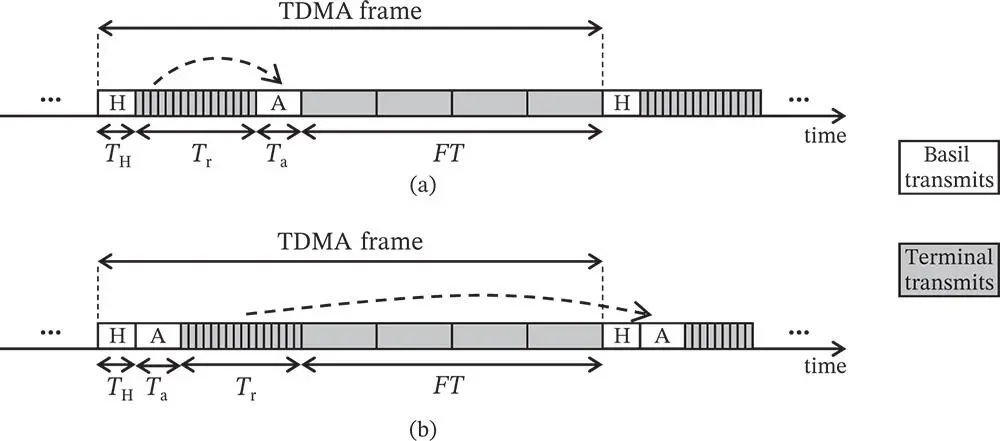1.4.3 Short Control Packets and the Idea of Reservation
Instead of directly allocating an uplink slot to send data, each device is given the opportunity to send a short control packet, termed a reservation packet , which is used to inform Basil how many slots for sending data it will need in the TDMA frame. We need to make a distinction between reservation and data packets. The reservation packet should only carry a few bits in order to indicate how many data slots in the frame it can use. For example, if the TDMA frame has a fixed number of  data slots, then the reservation packet should carry at least
data slots, then the reservation packet should carry at least  bits, as it should be able to describe numbers from 0 to
bits, as it should be able to describe numbers from 0 to  2 .
2 .
Figure 1.8(a)describes a possible way to use reservation packets. Basil sends the frame header H to indicate that it allows uplink reservation transmissions to start. This is followed by  reservation slots, that have a total duration to
reservation slots, that have a total duration to  . Here
. Here  is the total number of devices that have established a link with Basil. Each of the
is the total number of devices that have established a link with Basil. Each of the  devices is pre-allocated a unique reservation slot in which a user is allowed to send and it is guaranteed that there will no be a collision with another user. Due to this unique association between a device and a reservation slot, the reservation packets sent by the device do not need to carry the address of the device that transmits it. After the uplink reservation slots, Basil sends a short allocation packet A that announces how the data slots are allocated to different users. Considering the total number of possible allocations, the allocation packet A should contain
devices is pre-allocated a unique reservation slot in which a user is allowed to send and it is guaranteed that there will no be a collision with another user. Due to this unique association between a device and a reservation slot, the reservation packets sent by the device do not need to carry the address of the device that transmits it. After the uplink reservation slots, Basil sends a short allocation packet A that announces how the data slots are allocated to different users. Considering the total number of possible allocations, the allocation packet A should contain  bits. It should be noted that, through the reservation slots, the total amount of resources required by the devices can be larger than
bits. It should be noted that, through the reservation slots, the total amount of resources required by the devices can be larger than  . In this case Basil uses a certain scheduling policy to decide how to allocate the
. In this case Basil uses a certain scheduling policy to decide how to allocate the  data resources to the devices. The requests that are not met in that frame can be scheduled in future frames.
data resources to the devices. The requests that are not met in that frame can be scheduled in future frames.
 Figure 1.8 Uplink transmission with a reservation frame. (a) Case when the allocation is done based on the reservation outcome in the same TDMA frame. (b) Case when the allocation is done based on the reservation outcome in the previous TDMA frame.
Figure 1.8 Uplink transmission with a reservation frame. (a) Case when the allocation is done based on the reservation outcome in the same TDMA frame. (b) Case when the allocation is done based on the reservation outcome in the previous TDMA frame.
Figure 1.8(a)also illustrates the cost introduced by the reservation packets. If Basil somehow knows to whom to allocate the data slots in the current uplink frame, then the reservation slots should be omitted and the allocation packet A becomes a part of the frame header. We now proceed to evaluate how much the reservation slots are affecting the performance in terms of useful data rate experienced by the users. The total duration of the frame is  , where
, where  is the duration of the reservation frame,
is the duration of the reservation frame,  is the duration of the allocation frame, such that the data rate for a device that uses a single uplink slot is
is the duration of the allocation frame, such that the data rate for a device that uses a single uplink slot is
(1.5) 
which indicates the average data rate, observed in a period of a frame and by a terminal that has a single slot allocated to it.
While it is clear that the rate (1.5)is lower than  , we still lack an illustration of how short the reservation packet should be in order to justify its role. To do that, we need to enrich our system model with an additional assumption: the duration of a single bit is always equal to
, we still lack an illustration of how short the reservation packet should be in order to justify its role. To do that, we need to enrich our system model with an additional assumption: the duration of a single bit is always equal to  , regardless of whether it is a bit that belongs to a data packet or a bit describing a signaling information (headers/reservation/allocation). Denote by
, regardless of whether it is a bit that belongs to a data packet or a bit describing a signaling information (headers/reservation/allocation). Denote by  the number of bits in a data packet, such that
the number of bits in a data packet, such that  . Thus, we can express the durations
. Thus, we can express the durations  as fractions of
as fractions of  :
:
(1.6) 
where it is assumed that the header has only two bits, a reservation packet contains  bits, while the allocation packet has
bits, while the allocation packet has  bits. Using (1.5)we get:
bits. Using (1.5)we get:
(1.7) 
The effect of the overhead caused by sending signaling information is more clearly seen if, instead of (1.7), we look at the total useful data sent in a frame, irrespective of which user is sending it. This is often called sum rate or system goodput and in this particular case can be expressed as:
Читать дальше

 data slots, then the reservation packet should carry at least
data slots, then the reservation packet should carry at least  bits, as it should be able to describe numbers from 0 to
bits, as it should be able to describe numbers from 0 to  2 .
2 . reservation slots, that have a total duration to
reservation slots, that have a total duration to  . Here
. Here  is the total number of devices that have established a link with Basil. Each of the
is the total number of devices that have established a link with Basil. Each of the  devices is pre-allocated a unique reservation slot in which a user is allowed to send and it is guaranteed that there will no be a collision with another user. Due to this unique association between a device and a reservation slot, the reservation packets sent by the device do not need to carry the address of the device that transmits it. After the uplink reservation slots, Basil sends a short allocation packet A that announces how the data slots are allocated to different users. Considering the total number of possible allocations, the allocation packet A should contain
devices is pre-allocated a unique reservation slot in which a user is allowed to send and it is guaranteed that there will no be a collision with another user. Due to this unique association between a device and a reservation slot, the reservation packets sent by the device do not need to carry the address of the device that transmits it. After the uplink reservation slots, Basil sends a short allocation packet A that announces how the data slots are allocated to different users. Considering the total number of possible allocations, the allocation packet A should contain  bits. It should be noted that, through the reservation slots, the total amount of resources required by the devices can be larger than
bits. It should be noted that, through the reservation slots, the total amount of resources required by the devices can be larger than  . In this case Basil uses a certain scheduling policy to decide how to allocate the
. In this case Basil uses a certain scheduling policy to decide how to allocate the  data resources to the devices. The requests that are not met in that frame can be scheduled in future frames.
data resources to the devices. The requests that are not met in that frame can be scheduled in future frames. Figure 1.8 Uplink transmission with a reservation frame. (a) Case when the allocation is done based on the reservation outcome in the same TDMA frame. (b) Case when the allocation is done based on the reservation outcome in the previous TDMA frame.
Figure 1.8 Uplink transmission with a reservation frame. (a) Case when the allocation is done based on the reservation outcome in the same TDMA frame. (b) Case when the allocation is done based on the reservation outcome in the previous TDMA frame. , where
, where  is the duration of the reservation frame,
is the duration of the reservation frame,  is the duration of the allocation frame, such that the data rate for a device that uses a single uplink slot is
is the duration of the allocation frame, such that the data rate for a device that uses a single uplink slot is
 , we still lack an illustration of how short the reservation packet should be in order to justify its role. To do that, we need to enrich our system model with an additional assumption: the duration of a single bit is always equal to
, we still lack an illustration of how short the reservation packet should be in order to justify its role. To do that, we need to enrich our system model with an additional assumption: the duration of a single bit is always equal to  , regardless of whether it is a bit that belongs to a data packet or a bit describing a signaling information (headers/reservation/allocation). Denote by
, regardless of whether it is a bit that belongs to a data packet or a bit describing a signaling information (headers/reservation/allocation). Denote by  the number of bits in a data packet, such that
the number of bits in a data packet, such that  . Thus, we can express the durations
. Thus, we can express the durations  as fractions of
as fractions of  :
:
 bits, while the allocation packet has
bits, while the allocation packet has  bits. Using (1.5)we get:
bits. Using (1.5)we get:











